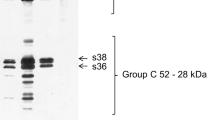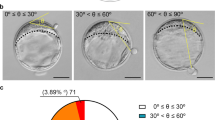Abstract
THE teratogenic effect of trypan blue in pregnant rats has been well established1–3. The dye appears to be most active when injected at 8½ days of pregnancy and gives rise to a variety of abnormalities involving almost all the systems of the embryo. Of a number of chemically related azo dyes tested, trypan blue was found to be the most active teratogenic agent in rats4 and it has also been shown to act as a teratogen in other rodents5–7 and in chicks8. Three main hypotheses explaining its action have been proposed. The first assumed that a part, at least, of the dye enters the blastocyst and acts directly on the embryonic cells9; the second postulates a ‘clogging’ of the yolk sac epithelium with the large dye molecules, thus inhibiting the transfer of essential substances to the conceptus ; the third suggests maternal metabolic changes resulting in the formation of substances which are responsible for the fœtal malformations.
This is a preview of subscription content, access via your institution
Access options
Subscribe to this journal
Receive 51 print issues and online access
$199.00 per year
only $3.90 per issue
Buy this article
- Purchase on Springer Link
- Instant access to full article PDF
Prices may be subject to local taxes which are calculated during checkout
Similar content being viewed by others
References
Gillman, J., Gilbert, C., Gillman, T., and Spence, I., S. Afr. J. Med. Sci., 13, 47 (1948).
Fox, M. H., and Goss, C. M., Anat. Rec., 124, 189 (1956).
Wilson, J. C., Anat. Rec., 130, 388 (1958).
Wilson, J. C., Anat. Rec., 123, 313 (1955).
Hamburg, M., Anat. Rec., 119, 409 (1954).
Ferm, V. H., J. Embryol. Exp. Morphol., 6, 284 (1958).
Harm, H., Z. Naturforsch., 9, b, 536 (1954).
Beaudoin, A. R., and Wilson, J. G., Proc. Soc. Exp. Biol. Med., 97, 85 (1958).
Wilson, J. G., Beaudoin, A. R., and Free, H. T., Anat. Rec., 133, 115 (1959).
Hartwell, J. L., and Fieser, L. F., “Org. Syn.”, 16, 12 (1936).
Okuneff, N., Biochem. Z., 193, 70 (1928).
Leeson, D., and Reeve, E. B., J. Physiol., 109, 170 (1949).
Wood, T., Biochem. J., 62, 611 (1956).
Author information
Authors and Affiliations
Rights and permissions
About this article
Cite this article
BECK, F., SPENCER, B. & BAXTER, J. Effect of Trypan Blue on Rat Embryos. Nature 187, 605–607 (1960). https://doi.org/10.1038/187605a0
Issue Date:
DOI: https://doi.org/10.1038/187605a0
This article is cited by
-
The so-called red impurity of trypan blue
Experientia (1972)
-
The impurities of biological dyes: their detection, removal, occurrence and histological significance?a review
The Histochemical Journal (1969)
-
Observations on the penetration and uptake of trypan blue in embryonic membranes of the mouse
Zeitschrift f�r Zellforschung und Mikroskopische Anatomie (1966)
-
Dosage – Response Curves for the Teratogenic Activity of Trypan Blue
Nature (1964)
-
Adsorption Chromatography of Direct Azo Dyes
Nature (1963)
Comments
By submitting a comment you agree to abide by our Terms and Community Guidelines. If you find something abusive or that does not comply with our terms or guidelines please flag it as inappropriate.



